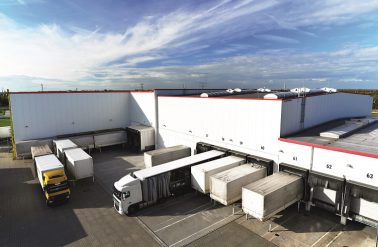The loading bay: How safe is your delivery?
 The latest statistics released by the Health and Safety Executive (HSE) indicate that there are over 5,000 accidents each year that involve workplace transport, with around 50 of these leading to fatalities. This means that the transport and storage sector has the second highest rate of total injuries out of all sectors. With around three million people working around vehicles out of the total working population, these statistics highlight the extent of the risks associated with a loading bay and delivery workplace context.
The latest statistics released by the Health and Safety Executive (HSE) indicate that there are over 5,000 accidents each year that involve workplace transport, with around 50 of these leading to fatalities. This means that the transport and storage sector has the second highest rate of total injuries out of all sectors. With around three million people working around vehicles out of the total working population, these statistics highlight the extent of the risks associated with a loading bay and delivery workplace context.
What’s the problem?
According to a report published by the Freight Transport Association, the most common risks presented by loading docks include: differing specifications for docks and vehicles, visiting drivers unfamiliar with new loading set-ups, and a lack of direct communication between drivers and warehouse staff. These issues are amplified when you add in difficult or unpredictable loads being dealt with. Warehouse-type scenarios are particularly prone to these sorts of issues, although you can find similar risks in any location where there is a loading element involved, such as a shop front or designated loading area.
Key loading dock hazards
The Freight Transport Association has identified the following as the most pressing risks in a loading dock context:
- Drive-away: This occurs when a vehicle moves from the loading bay too early
- Vehicle creep: When vehicles move incrementally due to jolts created by loading equipment, creating gaps between the vehicle and loading dock
- Load roll-away: This occurs when the load itself is stored on rolling transport equipment and rolls away
- Trail tip: When the trailer is uncoupled and mis-weighted, it can be prone to tipping forward
- Water ingress: Water entering from the dock loading area creates slip hazards around the loading bay
Communication breakdown
One of the most common reasons accidents occur in loading bay scenarios is simply due to communication problems, such as when a driver pulls out of the loading bay too early. This is a surprisingly common mistake to make and can be extremely dangerous. Simple measures you can take to address this could include:
- Warning or traffic lights
- The use of vehicle or trailer restraints
- Wheel chock blocks
- Traffic cones or barriers
- High visibility signage
Your responsibilities as an employer
Employers and premises owners have duties under the Health and Safety at Work Act 1974, as well as a number of other specific regulatory regimes, to maintain a safe working space in which any potential hazards are identified and controlled. A failure to do so will see them liable to the HSE under the 1974 act, as well as to their employees under the laws surrounding negligence and employer liability. As such, it is crucially important that employers and premises owners carefully assess any potential risks in their loading area and implement plans to manage them.
Improving your safety record
To lower the risk of occupational hazards occurring in loading bays, consider the following steps recommended by the Freight Transport Authority as best practice:
(1) Consult
(2) Design
(3) Build
(4) Train
(5) Implement
(6) Supervise
(7) Maintain
(8) Audit
(9) Review
